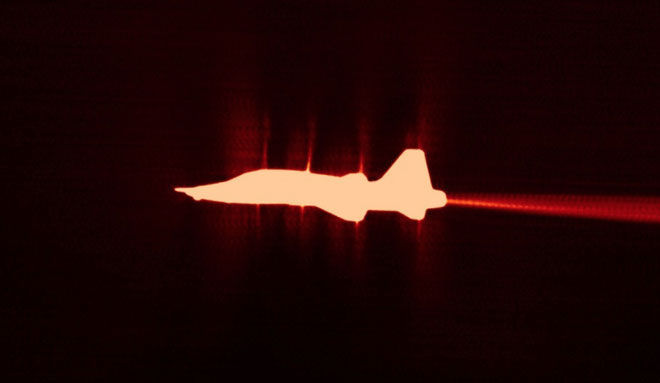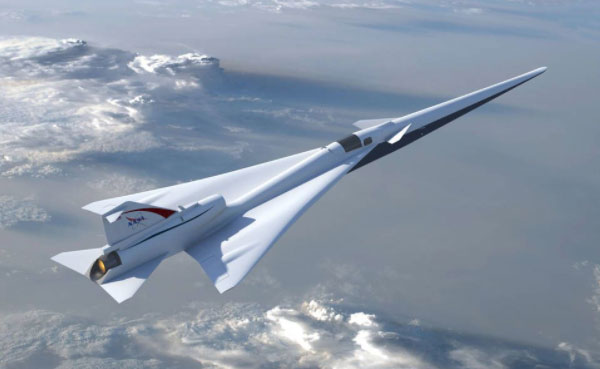NASA is developing an imaginary aircraft, flying faster than the speed of sound
The space agency's budget also requires a grant for a new type of aircraft that appears to exist only in sketches and in the imagination of NASA engineers: the X-Plane plane.
This aircraft is designed to fly faster than the speed of sound, and it can do that without creating supersonic explosions. If this project is successful, NASA's X-Plane could become a revolution for flights, and could cut flight time by half.
If NASA can apply for a successful fund, the first prototype X-Plane will take off in 2021.
NASA engineer David Richwwine said in an interview: "We are entering a very interesting phase here - we have enough money to be able to continue developing this project."

Aircraft engineers knew how to build aircraft that could break the sound barrier, such as the European airplane Concorde, a commercial aircraft with a capacity of over 100 people. However, governments will not allow the Concorde to fly over lands to protect its citizens from the effects of the aircraft.
In addition, supersonic explosions also produce bursts of sound waves that can damage high-rise buildings.
The X-Plane, unlike the Concorde, will be designed to emit underground explosions, and will only sound like "a heartbeat," according to Richwine, Deputy Project Manager for X-Plane, for good.
The complete design of this aircraft has not been decided yet, but it will look quite similar to the Concorde, with the fuselage designed to look like a needle, the wing of the aircraft is directed backwards, contrary to the airplane wing design of traditional aircraft.
In order to be able to break without causing supersonic waves, the aircraft will need to change its shape while flying. However, this change is very small, and passengers may find it difficult to realize that the aircraft is "transforming" while traveling on the flight.

A sketch of the X-Plane.
Rodney Bowersox, director of the National Aerotermochrome Laboratory in Texas, said: "A small tweak can bring about a big change when the plane is flying 100 kilometers above the ground."
In addition, the aircraft will also need to change its shape in different weather conditions to keep it quiet while flying.
Bowersox, who led a group responsible for changing the shape of the plane, said in an interview: " The goal is to change the shape of the plane so that the sound waves it produces born does not accumulate into a supersonic sound when it lands. "
"You will want a series of small waves to make it sound like a small vibration instead of sounding like an explosion."
This means that the fuselage will need to change its shape by about 1% while flying. To achieve this, the fuselage may appear small, which can be zoomed in or zoomed out to be able to deflect sound.

The Concorde is taking off.
These subtle changes are necessary for NASA's X-Plane.
Darren Hartl, an aerospace engineer at Texas A&M University, and a member of Bowersox's design team, said: "To be commercialized, this plane must be able to fly through. "He also commented that the business model of the Concorde is not feasible, because" you can only fly from New York to Paris. "
Until NASA could develop a commercial X-Plane, they planned to conduct a test by flying the aircraft over government lands, and then flying the aircraft through the neighborhoods. residence of the United States.

A model of the X-Plane.
However, there are still many difficulties for NASA before that can become a reality.
The Federal Aviation Administration will need to approve aircraft that can change shape when flying. It is likely that this process will take a few years.
Hartl said: "For a new type of aircraft to be put into production is a long process."
- NASA develops supersonic passenger aircraft
- S-512 supersonic jets fly 1.8 times faster than the speed of sound
- Passenger aircraft fly as fast as five times the speed of sound
- Discover the world's fastest reconnaissance aircraft
- Jump from a height of 39km with supersonic speed
- Passenger double speed test sound
- NASA participates in developing spacecraft five times faster than sound
- The flight crossed the first sound wall of mankind
- Bombers change shape
- The US is about to launch 20 times faster than sound
- The reason NASA still uses bombers since World War II
- It only takes 3 hours to fly from the US to England?
 'Fine laughs' - Scary and painful torture in ancient times
'Fine laughs' - Scary and painful torture in ancient times The sequence of numbers 142857 of the Egyptian pyramids is known as the strangest number in the world - Why?
The sequence of numbers 142857 of the Egyptian pyramids is known as the strangest number in the world - Why? History of the iron
History of the iron What is alum?
What is alum? Chinese hypersonic aircraft prototype reaches Mach 6 speed
Chinese hypersonic aircraft prototype reaches Mach 6 speed  NASA funds $11.5 million in research on future aircraft
NASA funds $11.5 million in research on future aircraft  AI system helps aircraft 'cope' with turbulence
AI system helps aircraft 'cope' with turbulence  Supersonic drone with speed up to 6,174km/h
Supersonic drone with speed up to 6,174km/h  NASA tests X-59 supersonic aircraft engine for the first time
NASA tests X-59 supersonic aircraft engine for the first time  Scientists plan to turn dead birds into drones
Scientists plan to turn dead birds into drones 